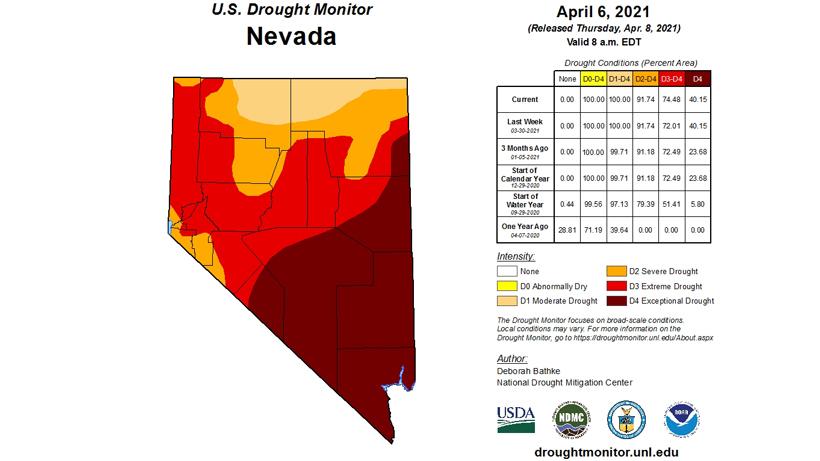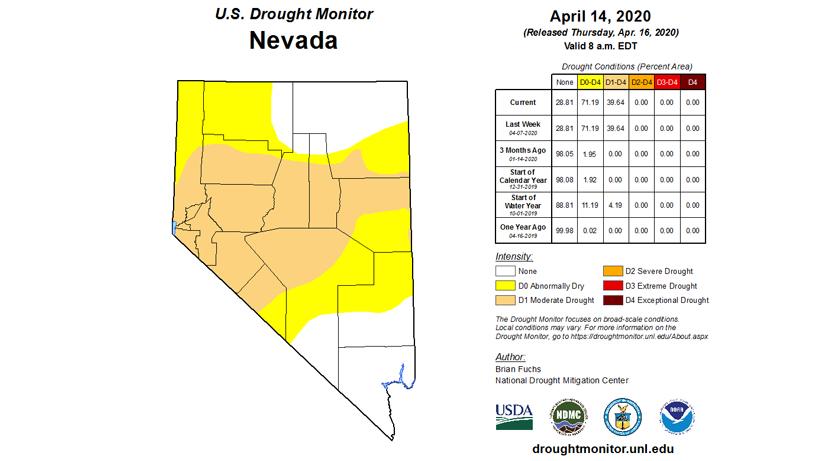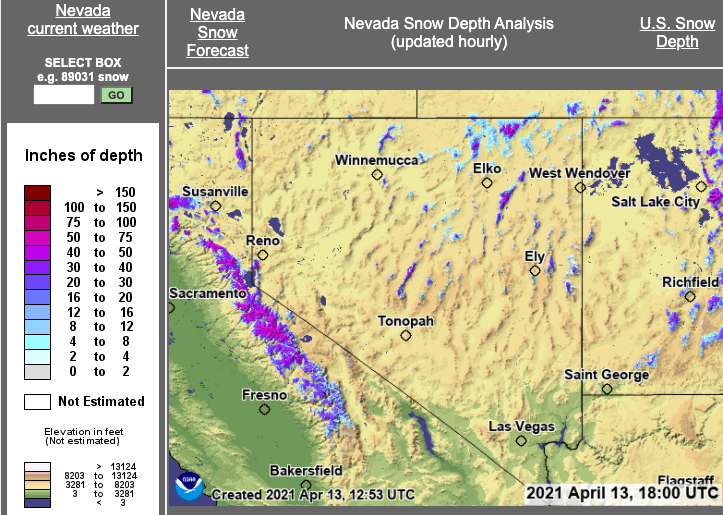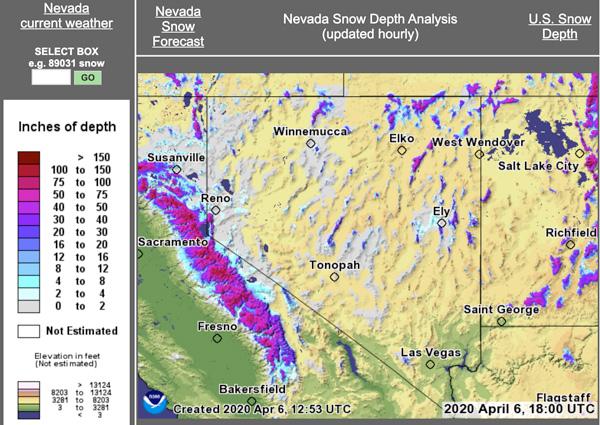




Nevada drought status as of April 6, 2021. Source: United States Drought Monitor

Nevada drought status from April 14, 2020. Source: United States Drought Monitor

Nevada's Snow Depth Analysis as of April 13, 2021. Source: Weatherstreet.com

Nevada's Snow Depth Analysis as of April 6, 2020. Source: Weatherstreet.com
Main writer: Jordan Christensen of The Draw
There is no question when talking about states that produce big mule deer that any relevant conversation will include Nevada. With one of the most rigid buck to doe management agenda’s in the country, this state knows how to grow big bucks. All this aside, Nevada can be a difficult pill to swallow even for the most committed application warrior because there is no maximum point draw. Additionally, with a draw process that is approaching 30 years, new applicants are very far behind the curve. Your odds at getting started are going to be relatively low and if you are looking to hunt some of the more notable areas of the state, then they are going to stay low for the duration of time it takes you to draw a hunt. So why apply? I believe this comes down to two factors: one would be logistics. If you live on the West Coast and are not applying for Nevada you are crazy. It's just too close to home not to take advantage of a chance to hunt that doesn’t involve traveling halfway across the country. The second reason is getting a crack at a giant. It’s that simple. If you want a chance to hunt units that have a strong track record for 180”+ deer, then you need to apply. There are number of units that have this track record and, although there is no clear finish line, because the system is as old as it is, most applicants have a less than 1% chance of drawing these permits, which means that you have just as good of odds of drawing as they do. And you can’t win if you don’t play. Nevada is not a good selection for hunters who want to hunt more often out West, but if you are looking for a next level deer hunt, then now is the time to get started. Maybe you won’t win a million bucks in Las Vegas, but there are more ways than one to come out a winner in the Silver State.
Note: The application deadline for all species in Nevada is May 10, 2021 at 11 p.m. PST for online applications. You can apply online here.
Remember that we have Draw Odds for female species. In Nevada, there are many opportunities for mule deer in the way of antlerless licenses for residents.
Note: antlerless mule deer permits are for residents only.
State quotas will not be set until the May 2021 commission meeting. This is done to ensure that the Nevada Department of Wildlife (NDOW) has the latest and most current data on big game herds.
To view important information and an overview of Nevada's rules/regulations, the draw system, tag and license fees and an interactive boundary line map, check out our State Profile. You can also view the Nevada Deer Profile to access historical and statistical data to help you find trophy areas.
Applying for a state you've never hunted before can be daunting but we are here to make it easy. In the video above, Trail goes over some of the most commonly asked questions when applying in Nevada.
Nevada drought status as of April 6, 2021. Source: United States Drought Monitor
Like many western states, the majority of Nevada is under extreme drought conditions. The northern portion of the state is faring better than the rest of the state, but is still in rough shape. The good thing is that over the last few weeks, it seems that things are headed in a better direction; however, we will need more of what we have seen over the last couple of weeks to really turn things around.
Nevada drought status from April 14, 2020. Source: United States Drought Monitor
Nevada's Snow Depth Analysis as of April 13, 2021. Source: Weatherstreet.com
Compared to 2020, snowpack is down. Many of the different smaller mountain ranges in the center of the state are lacking in snow and moisture overall and are a reflection of the current drought conditions.
Nevada's Snow Depth Analysis as of April 6, 2020. Source: Weatherstreet.com
For all species in Nevada, there are five hunt choices. When drawn, all five choices are considered prior to drawing the next application. If any selection is still available, you will be awarded the permit.
If you missed the application deadline to apply for a tag or you just want to apply for bonus points, then you may submit an application for a bonus point during the main big game application or within seven days after the application deadline. Application fees will still be charged. It is highly recommended that you print a copy of your application confirmation page for your records after applying. The last day to apply for a bonus point only is May 17, 2021 at 11 p.m. PST. You can apply for a bonus point here.
As mentioned before, Nevada should be considered a long-term goal and the key to success in this state is to keep applying and to only apply “point only” when you absolutely cannot pull off a hunt that fall. You never know when it’s going to be your year and to miss out on a year of having your name in the hat is a mistake that should be avoided whenever possible. If you are looking for a hunt sooner rather than later in the Silver State, Nevada makes it possible to chase the odds while still applying for a top-shelf hunt by allowing the applicant to select five choices each year.
With five choices available, the first two selections on your application should always be for the best units in the state or the hunt you desire the most. The last three selections can be a continuation of this strategy or allow the applicant to aggressively chase the odds and often draw in many fewer years. The applicant will lose all his/her points on any successful application regardless of which choice so be realistic in what kind of hunt you are looking for and always swing for the fence on your first two selections. Remember that your bonus points are squared each year plus one additional point for that year’s application. See the Nevada State Profile for more information.
Junior youth tag holders can harvest an antlered or antlerless deer. This tag allows the junior hunter to hunt during the archery season when the unit is open for archery only, to hunt with a muzzleloader when the unit is open for muzzleloader only and to hunt with any legal weapon when the unit is open for any legal weapon. If a junior hunt applicant is unsuccessful in drawing a tag, bonus points will be awarded for the junior hunt.
Note: Any bonus points accrued in the junior hunt will automatically transfer to the antlered deer category at the time the junior hunter becomes ineligible for the junior hunt by either age or after five years of applying for the junior hunt.
Junior youth must be 12 years old prior to the opening of each hunt choice applied for (usually archery) and must not turn 18 until after the last day of the last season applied for (usually any legal weapon). An eligible junior hunter may apply no more than five times.
There is not a single unit in Nevada that isn’t considered good mule deer habitat. Whether it’s the very top of the Ruby’s or the vast miles of BLM ground all across the state: if there is water, there is a chance to find deer. Couple this with the state's management plan, which is set at 30 bucks for every 100 does and you can see why the Silver State is and has been a top-shelf destination for mule deer hunters for generations. However, like anything, there are areas of the state that stand out and are considered better than others. The point here is that you could stumble into a giant buck just about anywhere in Nevada and, depending on whether you decided to wait it out for one of these top-shelf units or decide to take your chances in the less notable areas, anytime you have a tag in Nevada you have a chance to take the buck of a lifetime.
In 2019, there was not a statewide count of deer and in the areas that were studied the division observed approximately 10,500 deer. Within this group, there was an overall fawn production of 45:100 fawns to does, which was down from 2018’s count of 49:100. However, in the spring count of 2020, only 27 fawns were still observed to every 100 does, which means that almost half of the fawn crop was lost over the winter. The estimated population of deer in Nevada currently is considered to be 92,000. Overall, there is not much change to the state's herd conditions and the herd is considered stable.
Maximum bonus points for mule deer: 28
With zero points, there are a few options that you will likely have a 100% chance of drawing in Nevada. These are archery hunts in areas that are not managed as rigidly as other places in the state and are more set up for an opportunity to go hunting than anything else. If you don’t want to wait because you are just coming off your waiting period or you are just getting started, you could consider using one of your choices for a hunt like this. However, it would be a good idea to swing for the fence on some of the harder to draw hunts as your first few choices. Who knows? Maybe you will be one of the lucky ones and draw early and land a high profile permit way earlier than expected.
Getting started in Nevada is a daunting thought considering that there is no finish line and, if you ever draw, it will likely be because of some level of luck. However, I personally apply in Nevada because I would like to hunt in an area where I have a chance to harvest the best buck of my life even while knowing that this is a very difficult tag to draw. I don’t ever expect to draw one, but you can’t win if you don’t play and I have plenty of other applications across the country that I apply for because I love to go hunting. The other train of thought is that even the least notable units in Nevada are managed more strictly for buck to doe ratios, age class, etc., so if you decide you want to hunt more often — even in less desirable units — you can and could luck into an above average deer. Either way is fine, but understanding your goal before you get started will help you a lot in this state because without a maximum point draw, this application can seem like an eternal commitment without any rhyme or reason.
With 10 points, there are a number of options to consider. As of last year, there were 16 archery hunts that you could choose to hunt that will be 100% odds of drawing and 14 rifle hunts where your odds of drawing will be 50% or better. Yet, none of these are considered top-shelf hunts and, although they are available, you should really do your research to ensure that the hunt you are looking at has a track record of producing the caliber of bucks you want along with a reasonably good success rate. 10 years is a long time to wait for a hunt that turns into a flop.
Choosing to burn your points at this time is a decision you shouldn’t take lightly. You are a decade into your plan and, unfortunately, walking up to a nice deer is getting less and less desirable, considering the time you have invested at this point. There are number of archery hunts where you will have better than average odds at drawing, but none of them are in areas that have a strong track record for big deer. Additionally, outside of an inside track on a specific buck or a property that you will get access to that has a solid track record, the hunt you are hoping for is still likely to have very low odds. Stay the course and continue to apply for what you believe to be your dream hunts as your first few choices at least — even if you decide to settle for something less than top-shelf. Who knows? It could be your year.
Well, this is embarrassing. I am not sure why the draw gods have turned their back on you, but I hope it is because you have tunnel vision on one specific tag and just haven’t had the luck you are looking for. If you have been using all five choices for this long and a tag of some kind has not made its way into your pocket, then that is just some seriously bad luck. All things considered, this is likely to happen to more hunters than we all care to admit and without a maximum point draw in Nevada (as we stated earlier) it does require some level of luck in order to draw. Hopefully, this is your year. It’s been a long wait, but as they say all good things come to folks just like you. Currently, there is not a tag in the state that you would not have at or close to at least a 1:4 chance at. Apply carefully and don’t use all five choices unless they all fit the bill for what your goal is.
Without a maximum point draw in Nevada, this is the beginning of a very frustrating time in Nevada for applicants like yourself. You have waited a long time for a top-shelf hunt to come down the pipeline and there is not a clear finish line in sight unless you choose to settle for a less than elite hunt. That is not likely your plan and the only real advice is to think carefully about using all five choices at this point and ensure that the hunts you are applying for all line up with your current goals. Given the drought conditions, this is not a year to roll the dice on a unit that doesn’t have a strong track record for older-age class bucks.
For an additional $25 you can select to be included in the Silver State tag drawings, which would make you eligible for the one permit per species drawing each year that allows the recipient the opportunity to hunt any public land across the state from Aug. 1 to Dec. 31—just like the governor’s tag. This, along with thousands of dollars in free gear, is just too good to pass. Make sure you click the box while applying and get your name in the hat for this amazing opportunity.
Nevada Dream Tags are another shot at drawing the hunt of a lifetime for mule deer, antelope, desert bighorn sheep, California bighorn sheep, elk and black bear in Nevada. Dream Tags are similar to SuperTags and Super Raffles in other western states. This drawing is open to both residents and nonresidents and you are allowed to buy an unlimited number of raffle tickets for $5.75 plus processing fees for each for as many species as you want. You can enter the Dream Tag raffle here.
First-Come-First-Served (FCFS) queue that will be accessible in the Nevada Department of Wildlife’s (NDOW) licensing system. This queue offers NDOW customers the ability to purchase any tags remaining after the second draw or any returned tags without an eligible alternate. Just for the FCFS, the residency eligibility will not be restricted to tags within the queue. So, a nonresident can purchase a resident tag at the nonresident price and vice versa. The only exception is for the junior mule deer/antlerless mule deer tags, which will only be available to eligible resident juniors.
You now have the choice to defer a tag or restore your bonus points if you experience an extenuating circumstance between the 14-day window of the tag return deadline and the start of the hunt. A tag holder can transfer their tag to another eligible person if the tag holder is diagnosed as terminally ill after drawing the tag. Both the tag holder and the transferee would be subject to all eligibility restrictions. An extenuating circumstance is defined in NAC502.422 and must be accompanied with documentation evidence and verified by NDOW before approval.
An 11-year-old junior who will turn 12 before the beginning of the last season on their application is eligible to apply for a bonus point.
Active members in the Armed Forces who are stationed outside of the US and lose their bonus points due to a lapse in applying may now be refunded their lost points after they return to the country.
Party hunt members are able to return their party tag to NDOW, but will not receive a refund in bonus points unless all members of that party also return their tags to the agency.
Start applying now.
The deadline to apply is May 10, 2021 at 11 p.m. PST.
You can apply online here.
Bonus point only applications will be accepted until May 17, 2021 at 11 p.m. PST.
You can apply for a bonus point only here. You will still need to purchase a hunting license.
Results will be made available on or before May 26, 2021.
Second draw deadline for leftover tags is June 14, 2021 at 11 p.m. PST.
Second draw results will be available on or before July 9, 2021
Unit | |
|---|---|
Trophypotential | 180" |
Buck:doeratio | 35:100 |
% bucks 4point or better | 49% |
Public land% | 68.90% |
Unit | |
Trophypotential | 180" |
Buck:doeratio | 35:100 |
% bucks 4point or better | 61% |
Public land% | 77.4% |
Unit | |
Trophypotential | 180" |
Buck:doeratio | 28:100 |
% bucks 4point or better | 61% |
Public land% | 92.9% |
Unit | |
Trophypotential | 180" |
Buck:doeratio | 35:100 |
% bucks 4point or better | 61% |
Public land% | 57.8% |
Unit | |
Trophypotential | 180" |
Buck:doeratio | 35:100 |
% bucks 4point or better | 61% |
Public land% | 53.4% |
Unit | |
Trophypotential | 180" |
Buck:doeratio | 27:100 |
% bucks 4point or better | 84% |
Public land% | 75.8% |
Unit | |
Trophypotential | 180" |
Buck:doeratio | 52:100 |
% bucks 4point or better | 64% |
Public land% | 93.9% |
Unit | |
Trophypotential | 190" |
Buck:doeratio | 39:100 |
% bucks 4point or better | 45% |
Public land% | 98.3% |
Unit | |
Trophypotential | 190" |
Buck:doeratio | 39:100 |
% bucks 4point or better | 45% |
Public land% | 97.6% |
Unit | |
Trophypotential | 180” |
Buck:doeratio | 39:100 |
% bucks 4point or better | 45% |
Public land% | 98.3% |
Unit | |
Trophypotential | 180” |
Buck:doeratio | 25:100 |
% bucks 4point or better | 34% |
Public land% | 97.4% |
Unit | |
Trophypotential | 180” |
Buck:doeratio | 25:100 |
% bucks 4point or better | 34% |
Public land% | 98.9% |
Unit | |
Trophypotential | 180” |
Buck:doeratio | 13:100 |
% bucks 4point or better | 29% |
Public land% | 36.8% |
Unit | |
Trophypotential | 190” |
Buck:doeratio | 33:100 |
% bucks 4point or better | 58% |
Public land% | 51.7% |
Unit | |
Trophypotential | 180” |
Buck:doeratio | 33:100 |
% bucks 4point or better | 58% |
Public land% | 41.5% |
Unit | |
Trophypotential | 180” |
Buck:doeratio | 29:100 |
% bucks 4point or better | 58% |
Public land% | 96.2% |
Unit | |
Trophypotential | 180” |
Buck:doeratio | 29:100 |
% bucks 4point or better | 58% |
Public land% | 99.1% |
Unit | |
Trophypotential | 190” |
Buck:doeratio | 29:100 |
% bucks 4point or better | 62% |
Public land% | 96.8% |
Unit | |
Trophypotential | 190” |
Buck:doeratio | 47:100 |
% bucks 4point or better | 82% |
Public land% | 99.6% |
Unit | |
Trophypotential | 190” |
Buck:doeratio | 47:100 |
% bucks 4point or better | 82% |
Public land% | 97.7% |
Unit | Trophypotential | Buck:doeratio | % bucks 4point or better | Public land% |
|---|---|---|---|---|
180" | 35:100 | 49% | 68.90% | |
180" | 35:100 | 61% | 77.4% | |
180" | 28:100 | 61% | 92.9% | |
180" | 35:100 | 61% | 57.8% | |
180" | 35:100 | 61% | 53.4% | |
180" | 27:100 | 84% | 75.8% | |
180" | 52:100 | 64% | 93.9% | |
190" | 39:100 | 45% | 98.3% | |
190" | 39:100 | 45% | 97.6% | |
180” | 39:100 | 45% | 98.3% | |
180” | 25:100 | 34% | 97.4% | |
180” | 25:100 | 34% | 98.9% | |
180” | 13:100 | 29% | 36.8% | |
190” | 33:100 | 58% | 51.7% | |
180” | 33:100 | 58% | 41.5% | |
180” | 29:100 | 58% | 96.2% | |
180” | 29:100 | 58% | 99.1% | |
190” | 29:100 | 62% | 96.8% | |
190” | 47:100 | 82% | 99.6% | |
190” | 47:100 | 82% | 97.7% |